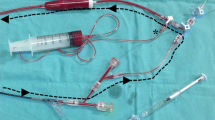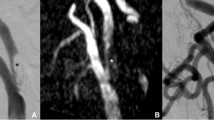Abstract
Objectives
As in-stent protrusion (ISP) during carotid artery stenting (CAS) may cause postoperative embolism, ISP detection is important. Intravascular ultrasound examination (IVUS) is useful for ISP detection because the blood vessel cross-section can be drawn as a tomogram from the lumen. Our objective was to clarify the occurrence of ISP during CAS using IVUS and relevant factors, and to report the usefulness of stent-in-stent placement when treating ISP.
Methods
In 142 consecutive patients (128 men, average age 71.7 years; 69 symptomatic) who underwent CAS using dual protection and the blood aspiration method, and subsequent IVUS after stent placement were included. The outcome of CAS, and the occurrence rate of ISP and related factors (plaque characteristics, stent design, intraoperative debris capture rate and postoperative diffusion-weighted imaging (DWI) positive rate) were examined.
Results
All CAS procedures were successful and no major adverse events (MAEs) were observed at 30 days. ISP was found in 12% (17/142), and stent-in-stent placement was performed in all cases. Vulnerable plaques were observed in 12 of 17 ISP cases (71%). A closed stent was used in 13 of 17 ISP cases (71%). The intraoperative debris capture rate was 100%, and no neurological symptoms were observed in any patients. A significant increase in ISP susceptibility was related to vulnerable plaques and the intraoperative debris capture rate.
Conclusions
Vulnerable plaques and debris capture were significantly correlated with ISP occurrence. In all ISP cases, stent-in-stent placement was performed and good results were obtained.
Key Points
• ISP detection during CAS using IVUS is important.
• ISP-positive patients were correlated with NASCET ≥ 80%, vulnerable plaques and stent length.
• Adequate additional treatment of stent in stenting under reliable protection against ISP-positive patients achieved low perioperative complications.


Similar content being viewed by others
Abbreviations
- AV:
-
Arteriovenous
- CAS:
-
Carotid artery stenting
- CC:
-
Close-cell design stent
- CCA:
-
Common carotid artery
- CEA:
-
Carotid endarterectomy
- CREST:
-
Carotid Revascularization Endarterectomy vs. Stenting Trial
- DSA:
-
Digital subtraction angiography
- DWI:
-
Diffusion-weighted imaging
- ECA:
-
External carotid artery
- HIS:
-
High-intensity signal
- ICA:
-
Internal carotid artery
- ISP:
-
In-stent protrusion
- IVUS:
-
Intravascular ultrasound
- MAE:
-
Major adverse events
- NASCET:
-
North American Symptomatic Carotid Endarterectomy Trial
- OC:
-
Open-cell design stent
- OCT:
-
Optical coherence tomography
- OFDI:
-
Optical frequency domain imaging
- PTA:
-
Percutaneous transluminal angioplasty
- TIA:
-
Transient ischaemic attack
References
Uno M (2015) Carotid Endarterectomy. Jpn J Neurosurg (Tokyo) 24:840–845
Shindo S, Fujii K, Shirakawa M et al (2016) Three-dimensional optical frequency domain imaging evaluation of novel dual-layered carotid stent implantation for vulnerable carotid plaque. J Stroke Cerebrovasc Dis 25:e31–e32
Cremonesi A, Setacci C, Manetti R et al (2005) Carotid angioplasty and stenting: lesion related treatment strategies. EuroIntervention. 1:289–295
Bosiers M, de Donato G, Deloose K et al (2007) Dose free cell area influence the outcome in carotid artery stenting? Eur J Vasc Endovasc Surg. 33:135–141 [discussion: 142-143]
Liu R, Jiang Y, Xiong Y et al (2015) An optical coherence tomography assessment of stent strut apposition based on the presence of lipid-rich plaque in the carotid artery. J Endovasc Ther. 22:942–949
Sakamoto S, Kiura Y, Okazaki T et al (2015) Usefulness of dual protection combined with blood aspiration for distal embolic protection during carotid artery stenting. Acta Neurochir (Wien) 157:371–377
Sakamoto S, Kiura Y, Okazaki T et al (2016) Carotid artery stenting for vulnerable plaques on MR angiography and ultrasonography: utility of dual protection and blood aspiration method. J Neurointerv Surg 8:1011–1015
Hayashi K, Kitagawa N, Morikawa M et al (2009) A case of internal carotid artery stenosis complicated with shower embolism during filter-protected carotid artery stenting. Brain Nerve 61:83–87
Kuroiwa T, Sakai N, Adachi H et al (2004) Stent-in-stenting for the Plaque Protrusion after Stent Deployments. Surg Cereb Stroke 32:107–111
Wehman JC, Holmes DR, Ecker RD et al (2006) Intravascular ultrasound identification of intraluminal embolic plaque material during carotid angioplasty with stenting. Catheter Cardiovasc Interv 68:853–857
Kotsugi M, Takayama K, Myouchin K et al (2017) Carotid artery stenting. Investigation of plaque protrusion incidence and prognosis. JACC Cardiovasc Interv 10:824–831
Shinozaki N, Ogata N, Ikari Y et al (2014) Plaque protrusion detected by intravascular ultrasound during carotid artery stenting. J Stroke Cerebrovasc Dis 23:2622–2625
Aikawa H, Kodama T, Nii K et al (2008) Intraprocedural plaque protrusion resulting in cerebral embolism during carotid angioplasty with stenting. Radiat Med 26:318–323
de Donato G, Setacci F, Sirignano P et al (2013) Optical coherence tomography after carotid stenting: rate of stent malapposition, plaque prolapse and fibrous cap rupture according to stent design. Eur J Vasc Endovasc Surg 45(6):579–587
Yohimura S, Kawasaki M, Yamada K et al (2012) Visualization of internal carotid artery atherosclerotic plaques in symptomatic and asymptomatic patients: a comparison of optical coherence tomography and intravascular ultrasound. AJNR Am J Neuroradiol 33:308–313
Yamada K, Yoshimura S, Miura M et al (2017) Potential of new-generation double-layer micromesh stent for carotid artery stenting in patients with unstable plaque: A preliminary result using OFDI analysis. World Neurosurg 105:321–326
Yoshimura S, Yamada K, Kawasaki M et al (2011) High-intensity signal on time-of-flight magnetic resonance angiography indicates carotid plaques at high risk for cerebral embolism during stenting. Stroke 42:3132–3137
Funding
The authors state that this work has not received any funding.
Author information
Authors and Affiliations
Corresponding author
Ethics declarations
Guarantor
The scientific guarantor of this publication is Prof. Kaoru Kurisu.
Conflict of interest
The authors of this manuscript declare no relationships with any companies whose products or services may be related to the subject matter of the article.
Statistics and biometry
No complex statistical methods were necessary for this paper.
Informed consent
Written informed consent was waived by the Institutional Review Board.
Ethical approval
Institutional Review Board approval was obtained.
Methodology
• Retrospective
• Case-control study
• Performed at one institution
Rights and permissions
About this article
Cite this article
Okazaki, T., Sakamoto, S., Shinagawa, K. et al. Detection of in-stent protrusion (ISP) by intravascular ultrasound during carotid stenting: Usefulness of stent-in-stent placement for ISP. Eur Radiol 29, 77–84 (2019). https://doi.org/10.1007/s00330-018-5636-3
Received:
Revised:
Accepted:
Published:
Issue Date:
DOI: https://doi.org/10.1007/s00330-018-5636-3




